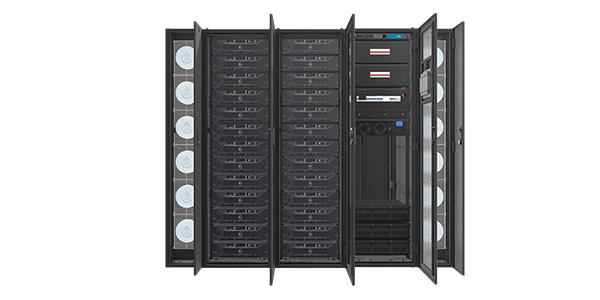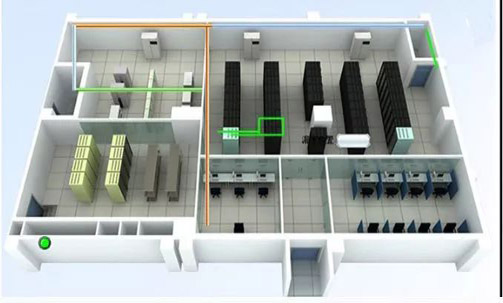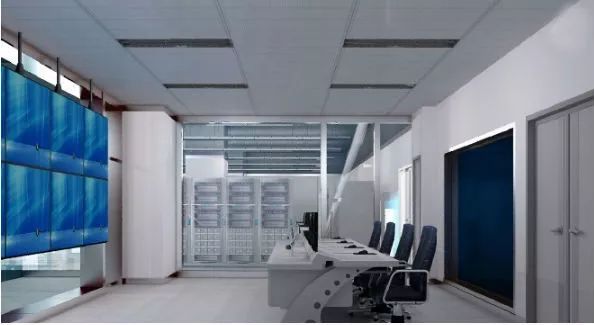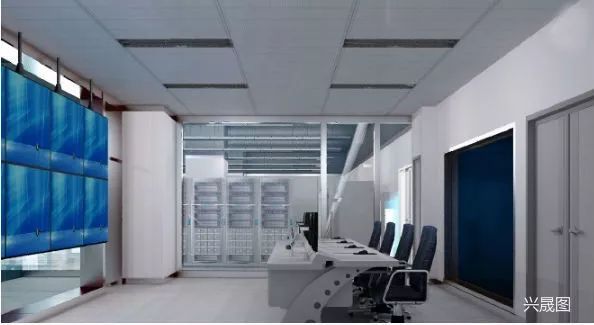

I. Overview
The computer room environment monitoring system is a computer network that comprehensively utilizes computer network technology, database technology, communication technology, automatic control technology, and new sensor technology. It provides an automation based on computer technology and based on centralized management monitoring mode. Intelligent and high-efficiency technical means, the system monitoring objects are mainly equipment room power and environmental equipment (such as: power distribution, UPS, air conditioning, temperature and humidity, water leakage, smoke, video, access control, fire protection system, etc.)

2. Items and contents of the computer room environment monitoring
1. Power distribution system
Mainly monitor the three-phase phase voltage, phase current, line voltage, line current, active power, reactive power, frequency, power factor and other parameters of the distribution system and the status monitoring of the distribution switch. When some important parameters exceed the danger limit, an alarm will be given.
2. UPS power supply (including DC power supply)
Real-time monitoring of the operation status of UPS internal rectifier, inverter, battery, bypass, load and other components through the communication protocol and intelligent communication interface provided by the UPS manufacturer. Once a component fails, the machine room power environment monitoring system will automatically Call the police. In the system, the monitoring line of UPS adopts the mode of monitoring only and not controlling.
3. Air-conditioning equipment
Through real-time monitoring, it can fully diagnose the operating condition of the air conditioner, monitor the operating status and parameters of the air conditioner components (such as compressor, fan, heater, humidifier, dehumidifier, filter, etc.), and can pass the power room environment monitoring system The management function can remotely modify the air conditioning setting parameters (temperature, humidity, humidity upper and lower limits, humidity upper and lower limits, etc.), and restart the precision air conditioner . Even if there is a slight failure of the air conditioning unit, it can be detected by the power environment monitoring system of the computer room, and timely measures are taken to prevent further damage to the air conditioning unit.
4. Temperature and humidity of the equipment room
At each important position in the equipment room, a temperature and humidity detection module needs to be installed to record the temperature and humidity curve for management personnel to query. Once the temperature and humidity are out of range, the alarm is immediately activated to remind the management personnel to adjust the working setting of the air conditioner in time or adjust the distribution of equipment in the equipment room
5. Water leak detection
There are two types of leak detection systems: positioning and non-positioning. The so-called positioning type refers to a leak detection system that can accurately report specific leak locations. The opposite is true without positioning the system. Only leaks can be reported, but the location cannot be indicated. The system consists of sensors and controllers. The controller monitors the status of the sensor and finds the water condition and immediately uploads the information to the monitoring PC. There are two types of leak detection sensors: wired detection and surface detection. Wire detection is mainly used in the computer room. Line detection uses a leak detection cord. Surround the water-affected area. After the water leakage occurs, the water will contact the detection line to give an alarm.
6. Smoke alarm
The smoke detector has a built-in microcomputer control, fault self-test, can prevent false alarms, output pulse level signals, relay switches or on and off signals. When smoke enters the ionization chamber, it will destroy the balance of the electric field of the smoke detector, and the alarm circuit Alarm is detected when the concentration exceeds the set threshold.
7. Video surveillance
The computer room environment monitoring system integrates video monitoring. The image adopts MPEG4 video compression mode, which integrates multi-screen measurement, video playback, video remote transmission, trigger alarm, PTZ control, and device linkage. The video system can also be combined with other input signals. Under the linkage, once the video alarms, it can be linked with other devices at the same time, such as dual-probe probe and door sensor to record.
8. Access control monitoring
The access control system is composed of a controller, an inductive card reader, an electronically controlled lock, and a door opening button (a networked system plus a communication converter. The card reading method belongs to a non-contact card reading method, and the system effectively monitors and manages the entry and exit personnel.
9. Fire protection system
The monitoring of the fire protection system is mainly the collection of fire alarm signals and gas spray signals, and does not control the fire protection system.

3. Functions of the computer room environment monitoring system
Monitoring / monitoring function
➤ The traditional computer room management adopts a system of daily inspections, such as checking each morning and evening, and manually recording some core operating parameters of the equipment and archiving them. The data obtained in this way is limited to a certain period of time, the work is monotonous and labor-intensive. The real-time monitoring function of the computer room environment monitoring system can solve this problem.
➤ The system has functions of remote monitoring, telemetry, remote control and remote adjustment, the so-called "four remotes", which centrally monitors and manages the entire system to achieve the goal of fewer people on duty and unattended.
➤ The system can collect the operating parameters, working status and alarm information of each device in real time. This system can monitor intelligent and non-intelligent equipment, and accurately realize the four remote functions of remote signaling, remote adjustment, remote control and remote adjustment. That is, it can not only truly monitor the various working states and operating parameters of the monitored field object equipment, but also remotely perform convenient control operations on the monitored field objects as needed, and can also remotely control the field object parameters with configurable operating parameters to modify.
➤ The system sets various levels of control contusion authority. If necessary and received the corresponding operation, the system administrator can configure the system monitoring objects, personnel authority, etc., and the system duty operator can remotely control or remotely adjust the related equipment in order to handle related events Or adjust the working status of the equipment to ensure that the equipment in the equipment room is operating in the best condition.
Alarm function
➤ a) No matter what interface the monitoring system console is in, it should prompt the alarm automatically in time, display and print the alarm information. All alarms use visual and audible sound and light alarm signals.
➤ b) Different levels of alarm signals should use different display colors and alarm sounds. The emergency alarm indicator flashes red, the important alarm flashes pink, and the general alarm flashes yellow.
➤ c) When an alarm occurs, you should confirm the alarm with the maintenance personnel. If you do not confirm within the specified time (determined according to the communication line), you can automatically notify the relevant personnel by telephone or mobile phone according to the set conditions. After the alarm is confirmed, the audible and visual alarm should stop. When a new alarm occurs, the audible and visual alarm function should be triggered again.
➤ d) Multi-site, multi-event simultaneous notification function, no missing alarm information, the alarm accuracy rate is 100%.
➤e) The system can shield and filter the alarms that do not need to respond.
➤f) The system can inquire, count and print various historical alarm information as needed. Various alarm information cannot be changed anywhere.
➤ g) In addition to the alarm function of the monitored object, the system can also perform self-diagnosis (for example, system power failure, communication line interruption, etc.), which can intuitively display the content of the fault, and the system is stable with stable self-protection capabilities.
➤ h) The system has the functions of querying and processing alarms conveniently and quickly according to user requirements.
➤ i) System alarms can be configured according to different requirements, such as alarm levels, alarm masks, and alarm thresholds.
➤ j) With electronic closed-loop dispatch function, it can realize the complete process of dispatching, receiving orders, maintaining, resuming orders and canceling orders.

Configuration management function:
➤ a) When the system is initially built and the equipment is changed or increased or decreased, the system management and maintenance personnel can use the configuration function to configure the system to ensure the consistency of the configuration parameters and the actual situation of the equipment.
➤ b) When the personnel on duty or system management and maintenance personnel changes, you can use the configuration function to authorize the relevant personnel accordingly.
➤ c) When the system is running, system management and maintenance personnel can also use the system configuration function to configure the parameters of the monitoring system to ensure that the monitoring system operates efficiently and accurately.
➤ d) System management and maintenance personnel can also use the system configuration function to configure the display mode, position, size, color, etc. of device parameters to achieve the effect of beautifying the interface.
➤ e) The configuration management operation is simple, convenient, and has good scalability. It can be configured online without interrupting the normal operation of the system.
➤ f) The monitoring system has the function of remote monitoring and management, and the configuration and modification of field parameters can be performed in the center or remotely.
➤ g) The system is configured by area and by profession, and displayed by area and by profession.
Security management function:
➤ a) The system provides multi-level passwords and multi-level authorizations to ensure the security of the system. The system records all operations for querying; the system manages the handover of shift staff
➤ b) The monitoring system has equipment operation records. The equipment operation records include the operator's employee number, the name of the operated equipment, operation content, and operation time.
➤ c) The monitoring system has records of operator login and logout time.
➤ d) The monitoring system is fault-tolerant, and the system cannot make an error, quit, or crash due to user misoperation.
➤ e) The monitoring system has self-diagnostic functions for its own hardware failures, communication failures between various monitoring levels, and software operation failures, and gives warning prompts.
➤ f) The system has self-starting kinetic energy for incoming calls.
➤ g) The system has system data backup and recovery functions.
Report management function:
➤a) The system can provide all equipment operation history data, statistical data, handover log, dispatch work order and curve graph query, report, statistics, classification, printing and other functions for the analysis and research of power operation and maintenance personnel.
➤b) The system also has user-defined report functions.
➤c) This system can manage the information related to the monitored equipment. Including various technical indicators of equipment, price, ex-factory date, operation status, maintenance and repair status, equipment installation wiring diagram, etc.
➤d) It can collect, display and record the status and operation data of each computer room monitoring point in the jurisdiction to provide management personnel with a full range of information query services.
Application of Computer Room Environmental Monitoring System
In the information construction, the operation of the computer room is at the core of information exchange management. All equipment in the equipment room must be in normal operation at all times. Otherwise, if a certain equipment fails, it will pose a threat to data transmission, storage and system operation, which will affect the operation of the global system. If not treated in time, it is more likely to damage the hardware, operating system, service delays, caused economic losses are not measurable.
Judging from the actual usage in some data centers at this stage, the management advantages of the computer room environmental monitoring system have been reflected, helping users solve many environmental protection problems in the computer room. Through the monitoring platform, most of the systems in the computer room can be managed, which greatly saves manpower and material resources. The construction of the weak monitoring system for the computer room. The construction of the computer room ’s environmental structure, equipment content, service requirements, and management models have passed through their four basic elements Contact to optimize the combination, thus providing a stable and reliable, reasonable investment, efficient and convenient, comfortable and safe machine room environment. The computer room environmental monitoring system is providing a reliable and first-class technical guarantee for the normal operation of the computer room of large data centers today.
The computer room environmental monitoring system supports secondary development and design. The system is mature and stable, with strong compatibility and expandability, high function integration, and convenient operation. It is suitable for network computer room projects such as banking, taxation, government, customs, radio and television, communications, and power.